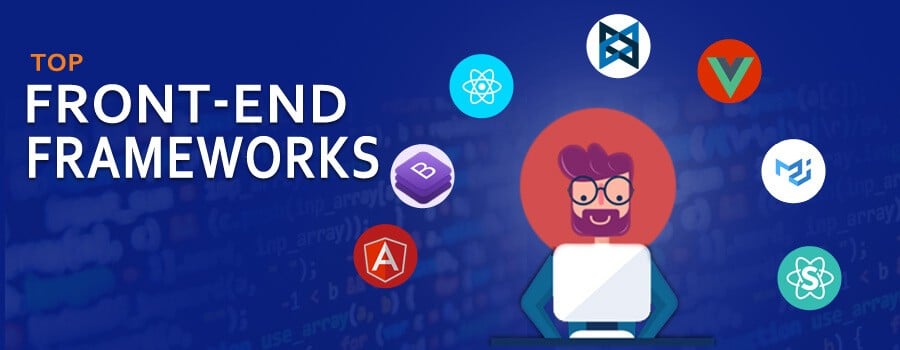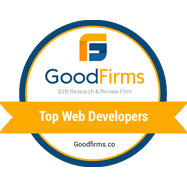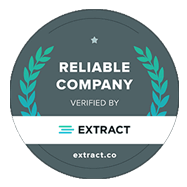We are using different technologies for web development. You might be aware of the term “front-end” and “back-end” pretty frequently. Just to refresh your front-end refers to what you see in websites and the back-end is more about behind the functionalities of front-end.
Front-End Framework
Front-end web development, also known as client-side development is the development to develop a view of the website which user can interact with directly or how your website looks like.
The front-end framework contains pre-written standardized code in the files and folder. A front-end framework is essentially a bundle of JavaScript code that you can include in your application to help you to build faster. We can say that the front-end framework is something that assists you in building front-end web technology faster as compared to you are doing on your own.
Top Front-end Framework
1.
AngularJS is an open-source JavaScript framework developed by Google based on model view controller architecture. AngularJS is one of the popular frameworks in 2019 to develop a dynamic web application. This framework is used to create a single page application. Angular has the largest community for the developer.
Pros:
1. Unit testable code
2. Clean and maintainable code
3. Re-usability
Cons:
1. JavaScript support is mandatory.
2. CLI documentation is lacking details.
2. 
React is an open-source JavaScript library that is used for building user interfaces. It is used to develop the view layer for web and page applications.
React allows a developer to develop the large application which can change data, without reloading the page.
ReactJS is also called to React or React.js.
Pros:
1. Easy to learn.
2. Performance and Testability
3. Data binding.
Cons:
1. Less documentation
2. The high pace of development
3. 
VueJS is an advanced JavaScript framework and uses to develop the user interface. VueJS is a popular front-end framework in 2019 and widely used in the web application.
VueJS uses virtual DOM alongside with other frameworks like React.
Pros:
1. Easy Routing
2. Flexibility
3. TypeScript Support
Cons:
1.Small Community
2.Language Barrier
4. 
Backbone is a lightweight framework that allows the developer to structure their JavaScript code in MVC architecture. The biggest advantage of the backbone is you can distinguish model, view, and controller.
Pros:
1. Useful library.
2. Easy event binding.
3. Support for Systematic and Organised code.
Cons:
1. Memory Leaking
2. Productivity
5. 
Bootstrap is a ready-made front-end framework use to develop the interactive web application and developed by Twitter. It provides the modular way there we can structure the CSS files per device and apply it.
Pros:
1. Save Time.
2. Better Responsiveness.
3. Excellent Grid System
Cons:
1. Heavy to load sometimes
2. Limited learning curve.
6. 
Foundation is an open-source front-end framework that helps in designing responsiveness websites, apps, and emails. Foundation consists of 12 columns grid system, supports stylized CSS components and compatible with several browsers.
Pros:
1.Compatibility
2.Built-in Widgets
3.Flexible grids
Cons:
1. It takes time to learn.
2. No support for troubleshooting issues.
7. 
If you have a small project and you don’t need the utility of a large framework than Skelton would be a good choice for you. The framework provides styles for standard HTML elements and includes a grid.
Pros:
1. Clean and beautiful code.
2. Best for beginners.
3. Compatible with different resolutions.
Cons:
1. Limited templates
2. The development time is higher.
8. 
The pure framework which is widely used in the web application with its small modules that you can use in every project. Pure has a responsive grid according to your customization and small file size 4.8kb.
Pros:
1. Lightweight
2. Flexibility
3. Secure
Cons:
1. Small community
2. Limited learning curve
9. 
Semantic is a web development framework that helps create beautiful, responsive layouts using Human-friendly HTML. Semantic-UI the simple debugging for the application and the framework is growing fast in 2019.
Pros:
1. Portable
2. User-friendly
3. Easy development
Cons:
1. Limited community
2. Language barrier.
10. 
Material-UI is small in size and hence it quickly loads web pages as possible. Material-UI is no external dependencies.
Pros:
1. Customizable.
2. No Dependencies
3. Small Footprint
Cons:
1. Small Community
2. Require skills for development
Conclusion:
There are so many front-end frameworks to learn but it totally depends on your project requirements. It would be fruitful to research your project completely and choose the front-end framework accordingly. The main purpose to use the framework is to save your time and build the application faster. If you have any doubts in this article feel free to contact us and drop your query. We want to hear from you.



















